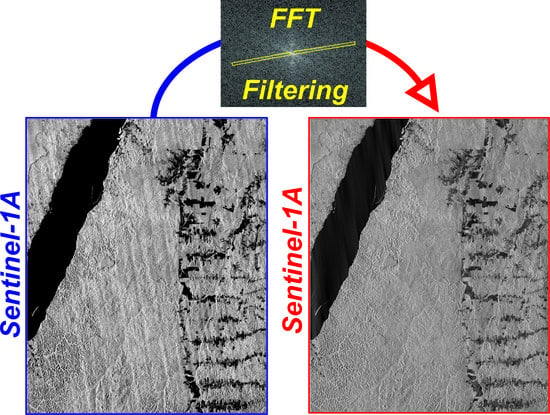Removal of Ionospheric Effects from Sigma Naught Images of the ALOS/PALSAR-2 Satellite
Abstract
:1. Introduction
2. Materials and Methods
2.1. Study Area
2.2. Methodological Approach
3. Results
3.1. Image Processing
3.2. Random Forest Classification
4. Discussion
5. Conclusions
Author Contributions
Funding
Institutional Review Board Statement
Informed Consent Statement
Data Availability Statement
Acknowledgments
Conflicts of Interest
Abbreviations
| SAR | Synthetic Aperture Radar |
| LULC | Land Use Land Cover |
| FFT | Fourier Fast Transform |
| AGB | Aboveground Biomass |
| OA | Overall Accuracy |
| IDL | Interactive Data Language |
| PALSAR | Phased Array L-band Synthetic Aperture Radar |
| ALOS | Advanced Land Observing Satellite |
| TNF | Tapajós National Forest |
| GNSS | Global Navigation Satellite System |
| RF | Random Forest Classifier |
| SNAP | Sentinel Application Platform |
| ENVI | Environment for Visualizing Images |
References
- Pielke, R.A. Land use and climate change. Science 2005, 310, 1625–1626. [Google Scholar] [CrossRef] [PubMed] [Green Version]
- Foley, J.A.; Defries, R.; Asner, G.P.; Barford, C.; Bonan, G.; Carpenter, S.R.; Chapin, F.S.; Coe, M.T.; Daily, G.C.; Gibbs, H.K.; et al. Global consequences of land use. Science 2005, 309, 570–574. [Google Scholar] [CrossRef] [PubMed] [Green Version]
- Junior, C.H.S.; Pessôa, A.C.; Carvalho, N.S.; Reis, J.B.; Anderson, L.O.; Aragão, L.E. The Brazilian Amazon deforestation rate in 2020 is the greatest of the decade. Nat. Ecol. Evol. 2021, 5, 144–145. [Google Scholar] [CrossRef] [PubMed]
- Lemos, A.L.F.; Silva, J.A. Desmatamento na Amazônia Legal: Evolução, causas, monitoramento e possibilidades de mitigação através do Fundo Amazônia. Revista Floresta e Ambiente 2011, 8, 98–108. [Google Scholar] [CrossRef]
- Matricardi, E.A.T.; Skole, D.L.; Costa, O.B.; Pedlowski, M.A.; Samek, J.H.; Miguel, E.P. Long-Term Forest Degradation Surpasses Deforestation in the Brazilian Amazon. Science 2020, 369, 1378–1382. [Google Scholar] [CrossRef]
- Qin, Y.; Xiao, X.; Wigneron, J.P.; Ciais, P.; Brandt, M.; Fan, L.; Li, X.; Crowell, S.; Wu, X.; Doughty, R.; et al. Carbon Loss from Forest Degradation Exceeds that from Deforestation in the Brazilian Amazon. Nat. Clim. Change 2021, 11, 442–448. [Google Scholar] [CrossRef]
- Kuck, T.N.; Sano, E.E.; Bispo, P.D.C.; Shiguemori, E.H.; Silva Filho, P.F.F.; Matricardi, E.A.T. A Comparative Assessment of Machine-Learning Techniques for Forest Degradation Caused by Selective Logging in an Amazon Region Using Multitemporal X-Band SAR Images. Remote Sens. 2021, 13, 3341. [Google Scholar] [CrossRef]
- Asner, G.P. Cloud cover in Landsat observations of the Brazilian Amazon. Int. J. Remote Sens. 2001, 22, 3855–3862. [Google Scholar] [CrossRef]
- Kasischke, E.S.; Melack, J.M.; Dobson, M.C. The use of imaging radars for ecological applications: A review. Remote Sens. Environ. 1997, 57, 141–156. [Google Scholar] [CrossRef]
- Henderson, F.M.; Lewis, A.J. Manual of Remote Sensing: Principles and Applications of Imaging Radars, 3rd ed.; John Wiley & Sons: New York, NY, USA, 1998; 866p. [Google Scholar]
- Santos, J.R.; Freitas, C.C.; Araújo, L.S.; Dutra, L.V.; Mura, J.C.; Gama, F.F.; Soler, L.S.; Sant’anna, S.J.S. Airborne P-band SAR applied to the above ground biomass studies in the Brazilian tropical rainforest. Remote Sens. Environ. 2003, 87, 482–493. [Google Scholar] [CrossRef]
- Wiederkehr, N.C.; Gama, F.F.; Castro, P.B.N.; Bispo, P.d.C.; Balzter, H.; Sano, E.E.; Liesenberg, V.; Santos, J.R.; Mura, J.C. Discriminating Forest Successional Stages, Forest Degradation, and Land use in Central Amazon Using ALOS/PALSAR-2 Full-Polarimetric Data. Remote Sens. 2020, 12, 3512. [Google Scholar] [CrossRef]
- Bispo, P.C.; Santos, J.R.; Valeriano, M.M.; Touzi, R.; Seifert, F.M. Integration of polarimetric PALSAR attributes and local geomorphometric variables derived from SRTM for forest biomass modeling in central Amazonia. Can. J. Remote Sens. 2014, 40, 26–42. [Google Scholar] [CrossRef]
- Dutra, L.V.; Scofield, G.B.; Neta, S.A.R.; Negri, R.G.; Freitas, C.C.; Andrade, D. Land cover classification in Amazon using Alos Palsar Full Polarimetric Data. In Simpósio Brasileiro de Sensoriamento Remoto; INPE: São José dos Campos, Brasil, 2009; Volume 1, pp. 7259–7264. ISBN 978-85-17-00044-7. (INPE-15865-PRE/10475). Available online: http://urlib.net/dpi.inpe.br/sbsr@80/2008/11.17.18.24 (accessed on 18 December 2021).
- Li, G.; Lu, D.; Moran, E.; Dutra, L.; Batistella, M. A comparative analysis of ALOS PALSAR L-band and RADARSAT-2 C-band data for land-cover classification in a tropical moist region. ISPRS J. Photogramm. Remote Sens. 2012, 70, 26–38. [Google Scholar] [CrossRef] [Green Version]
- Negri, R.; Dutra, L.; Freitas, C.D.C.; Lu, D. Exploring the Capability of ALOS PALSAR L-Band Fully Polarimetric Data for Land Cover Classification in Tropical Environments. IEEE J. Sel. Top. Appl. Earth Obs. Remote Sens. 2016, 9, 5369–5384. [Google Scholar] [CrossRef]
- Pôssa, E.M. Discriminação de uso e cobertura da terra na região amazônica a partir de informação polarimétrica ALOS/PALSAR e coerência interferométrica da missão TANDEM-X. Master’s Thesis, Instituto Nacional de Pesquisas Espaciais, São José dos Campos, Brasil, 2016. Available online: http://urlib.net/8JMKD3MGP3W34P/3L65BH8 (accessed on 16 December 2021).
- Costa, J.D.S.; Liesenberg, V.; Schimalski, M.B.; de Sousa, R.V.; Biffi, L.J.; Gomes, A.R.; Neto, S.L.R.; Mitishita, E.; Bispo, P.D.C. Benefits of Combining ALOS/PALSAR-2 and Sentinel-2A Data in the Classification of Land Cover Classes in the Santa Catarina Southern Plateau. Remote Sens. 2021, 13, 229. [Google Scholar] [CrossRef]
- Shimada, M.; Muraki, Y.; Otsuka, Y. Discovery of Anoumoulous Stripes Over the Amazon by the PALSAR onboard ALOS Satellite. In Proceedings of the IEEE International Geoscience and Remote Sensing Symposium (IGARSS), Boston, MA, USA, 7–11 July 2008; pp. II-387–II-390. [Google Scholar]
- Jensen, J.R. Sensoriamento Remoto do ambiente: Uma Perspectiva em Recursos terrestres, 2nd ed.; Epiphanio, T.J.C.N., Formaggio, A.R., Santos, A.R., De Almeida, C.M., Theodor Rudorff, B.R., Galvão, L.S., Eds.; Parêntese: São José dos CamposParêntese, Brazil, 2009; 625p. [Google Scholar]
- Meyer, F.J.; Chotoo, K.; Chotoo, S.D.; Huxtable, B.D.; Carrano, C.S. The Influence of Equatorial Scintillation on L-Band SAR Image Quality and Phase. IEEE Trans. Geosci. Remote Sens. 2015, 54, 869–880. [Google Scholar] [CrossRef]
- Paulino, I.; Medeiros, A.F.; Buriti, R.A.; Takahashi, H.; Sobral, J.H.A.; Gobbi, D. Plasma bubble zonal drift characteristics observed by airglow images over Brazilian tropical region. Revista Brasileira de Geofísica 2011, 29, 239–246. [Google Scholar] [CrossRef]
- Mendonça, M.A.M.; Monico, J.F.G.; Motoki, G.M. Efeitos da cintilação ionosférica na agricultura de precisão: Um estudo de caso. In Proceedings of the II Simpósio Brasileiro de Geomática e V Colóquio Brasileiro de Ciências Geodésicas, Presidente Prudente, Brasil, 24–27 July 2012; 2012; Volume 1, pp. 262–267. [Google Scholar]
- Sato, H.; Kim, J.S.; Wrasse, C.M.; Souza, J.R. Sounding the Origin Of L-Band SAR Stripes in the Equatorial Ionosphere: Coordinated Observation of Alos-2 And Air Glow Imager. In Proceedings of the IEEE International Geoscience and Remote Sensing Symposium (IGARSS), Yokohama, Japan, 28 July–2 August 2019; pp. 7702–7705. [Google Scholar]
- Roth, A.P.; Huxtable, B.D.; Chotoo, K.; Chotoo, S.D.; Caton, R.G. Detection and mitigation of ionospheric stripes in PALSAR data. In Proceedings of the IEEE International Geoscience and Remote Sensing Symposium, Munich, Germany, 22–27 July 2012; pp. 1621–1624. [Google Scholar] [CrossRef]
- Abdu, M.A.; Batista, I.S.; Takahashi, H.; MacDougall, J.; Sobral, J.H.; De Medeiros, A.; Trivedi, N.B. Magnetospheric disturbance induced equatorial plasma bubble development and dynamics: A case study in Brazilian sector. J. Geophys. Res. Earth Surf. 2003, 108, 13. [Google Scholar] [CrossRef] [Green Version]
- Gonzalez, R.C.; Woods, R.E. Digital Image Processing, 4th ed.; Pearson: New York, NY, USA, 2018; 1192p. [Google Scholar]
- Mather, P.M. Computer Processing of Remotely-Sensed Images; John Wiley & Sons: Chichester, UK, 1993. [Google Scholar]
- Richards, J.A. Remote sensing Digital Image Analysis; Spinger: Berlin/Heidelberg, Germany, 1995. [Google Scholar]
- Shimada, M.; Isoguchi, O.; Tadono, T.; Isono, K. PALSAR Radiometric and geometric calibration. IEEE Trans. Geosci. Remote Sens. 2009, 7, 3915–3932. [Google Scholar] [CrossRef]
- Hagensieker, R.; Waske, B. Evaluation of multi-frequency SAR images for tropical land cover mapping. Remote Sens. 2018, 10, 257. [Google Scholar] [CrossRef] [Green Version]
- Pavanelli, J.A.P.; Santos, J.R.; Galvão, L.S.; Xaud, M.; Xaud, H.A.M. PALSAR-2/ALOS-2 and OLI/LANDSAT-8 data integration for land use and land cover mapping in northern Brazilian Amazon. Boletim de Ciências Geodésicas 2018, 24, 250–269. [Google Scholar] [CrossRef]
- Diniz, J.M.F.S.; Gama, F.F.; Adami, M. Evaluation of polarimetry and interferometry of sentinel-1A SAR data for land use and land cover of the Brazilian Amazon region. Geocarto Int. 2020, v. 35, 1–19. [Google Scholar] [CrossRef]
- R Core Team. R: A Language and Environment for Statistical Computing; R Foundation for Statistical Computing: Vienna, Austria, 2020. Available online: https://www.R-project.org/ (accessed on 1 February 2022).
- Breiman, L. Random Forests. Mach. Learn. 2001, 45, 5–32. [Google Scholar] [CrossRef] [Green Version]
- ENVI. Using ENVI. Available online: https://www.l3harrisgeospatial.com/docs/routines-136.html (accessed on 5 February 2022).
- Belcher, D.P.; Cannon, P.S. Amplitude scintillation effects on SAR. IET Radar Sonar Navig. 2014, 8, 658–666. [Google Scholar] [CrossRef]
- Camargo, F.F.; Sano, E.E.; Almeida, C.M.; Mura, J.C.; Almeida, T. A Comparative Assessment of Machine-Learning Techniques for Land Use and Land Cover Classification of the Brazilian Tropical Savanna Using ALOS-2/PALSAR-2 Polarimetric Images. Remote Sens. 2019, 11, 1600. [Google Scholar] [CrossRef] [Green Version]
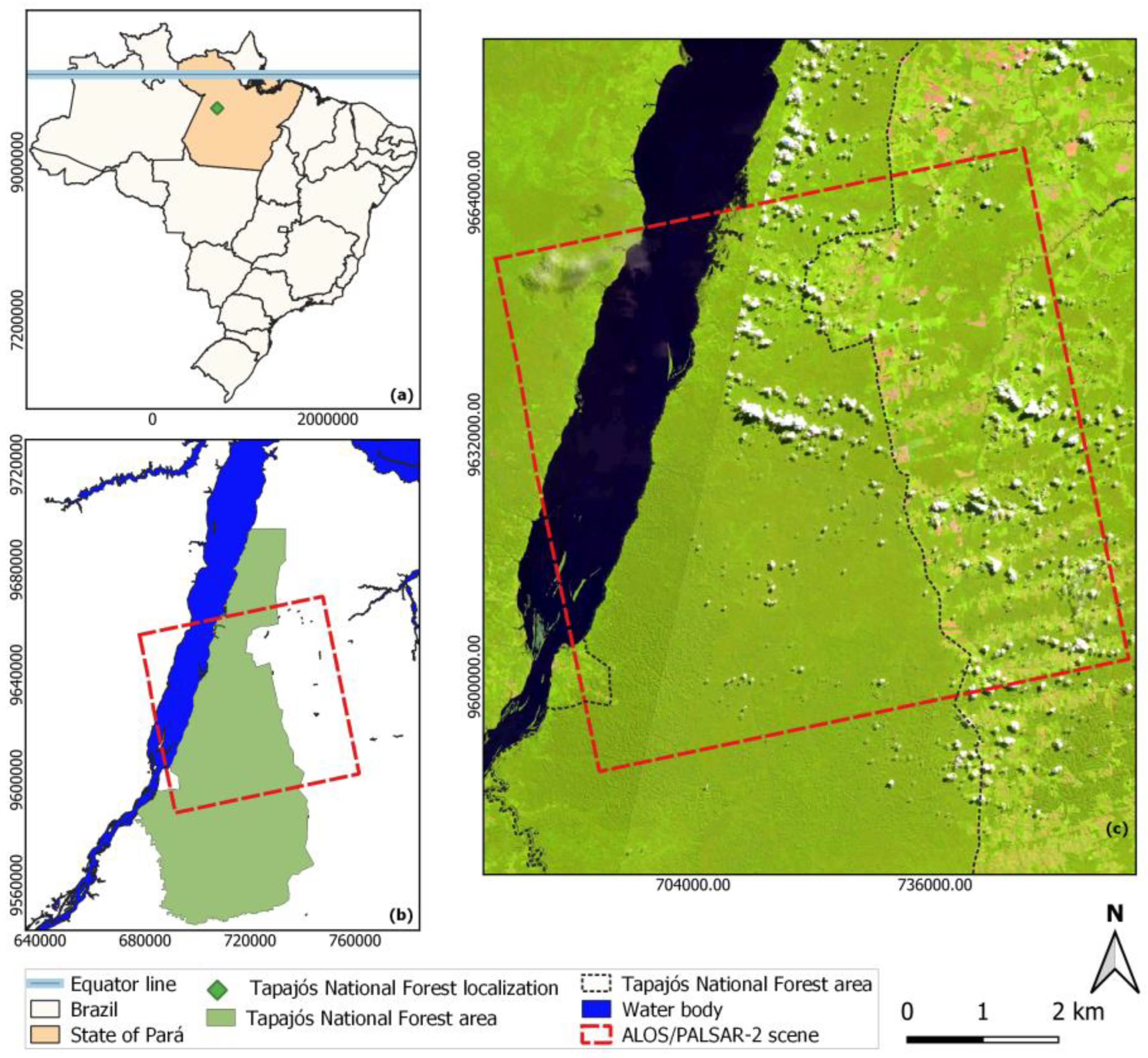
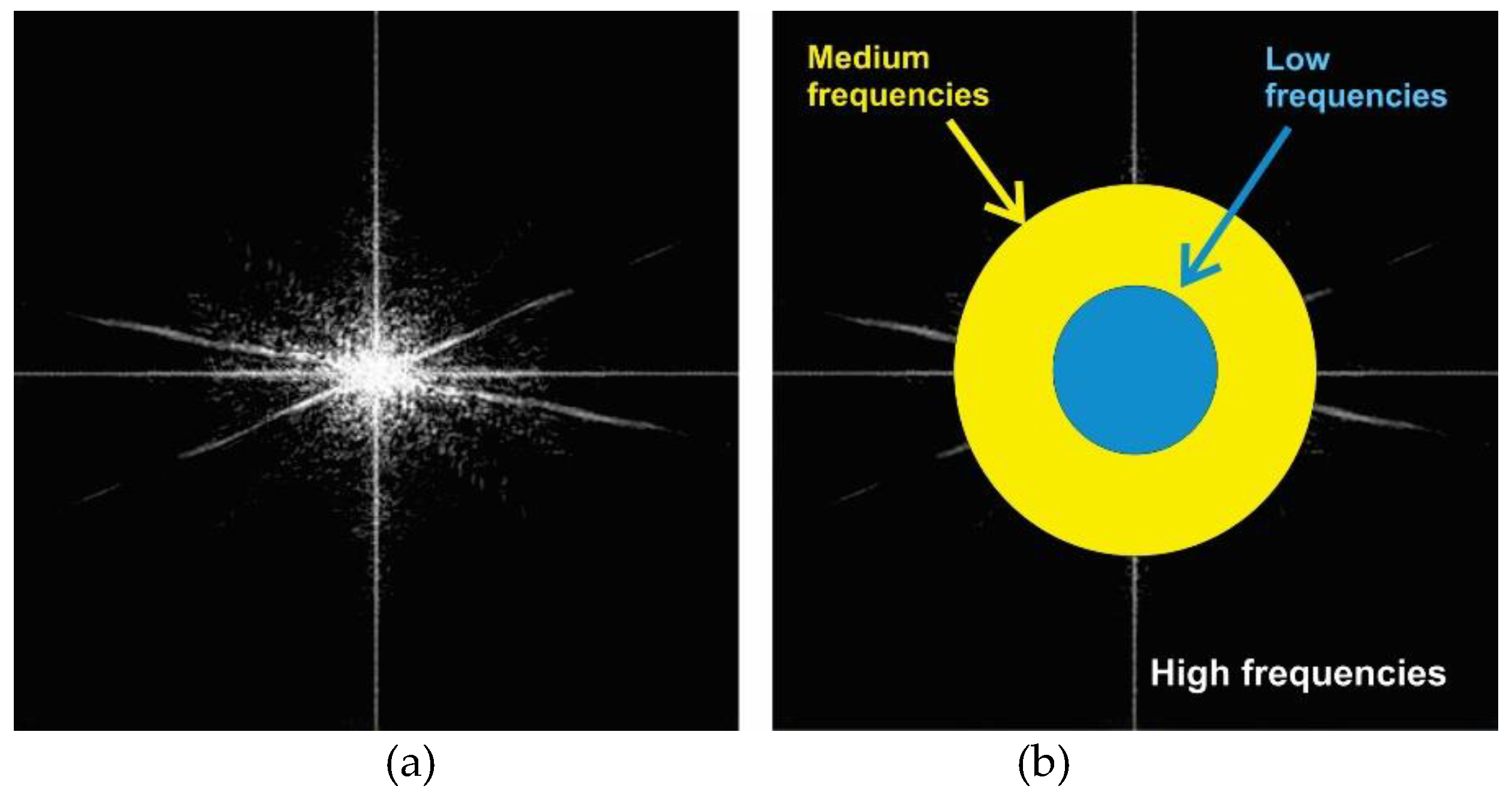

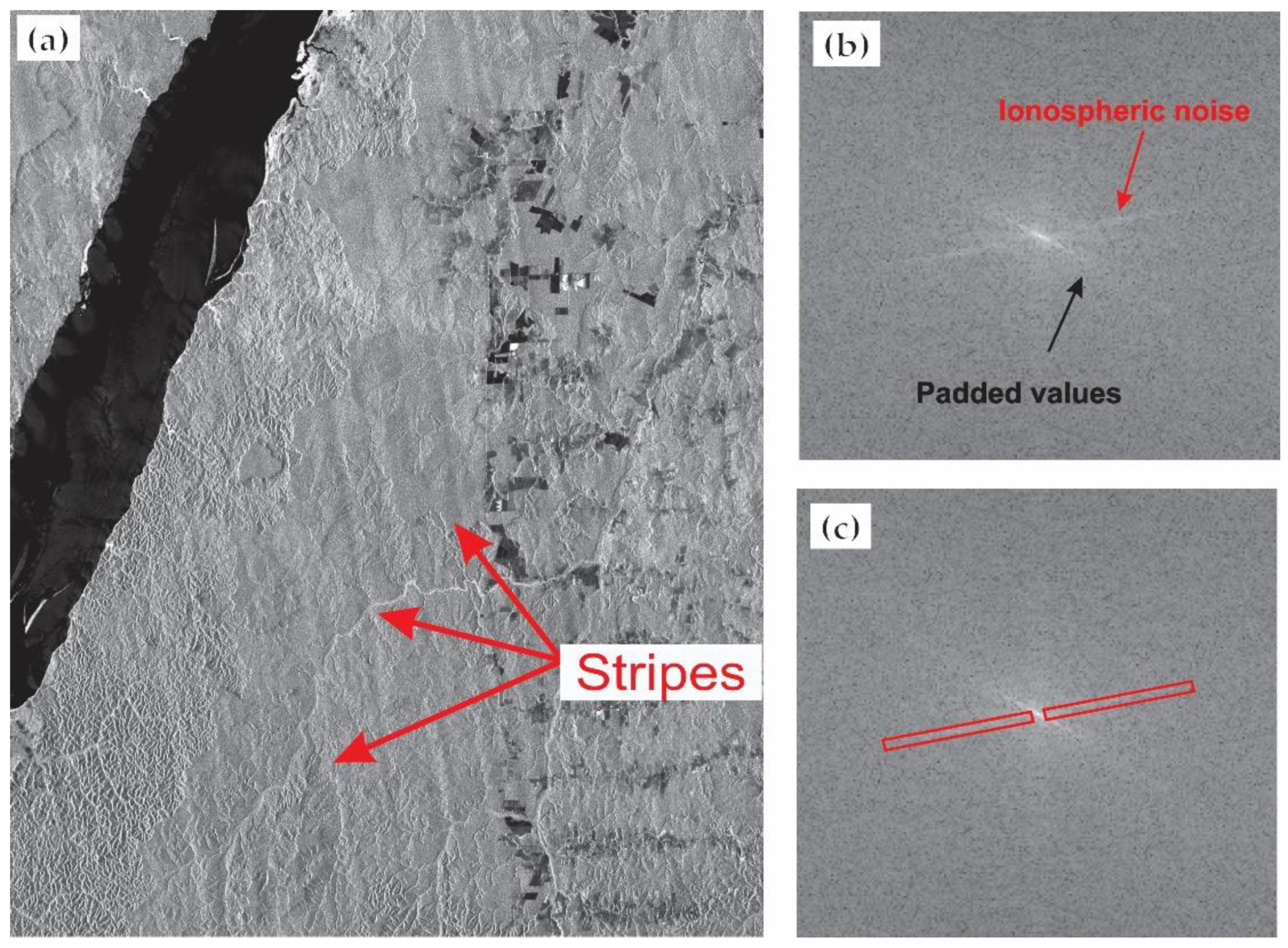
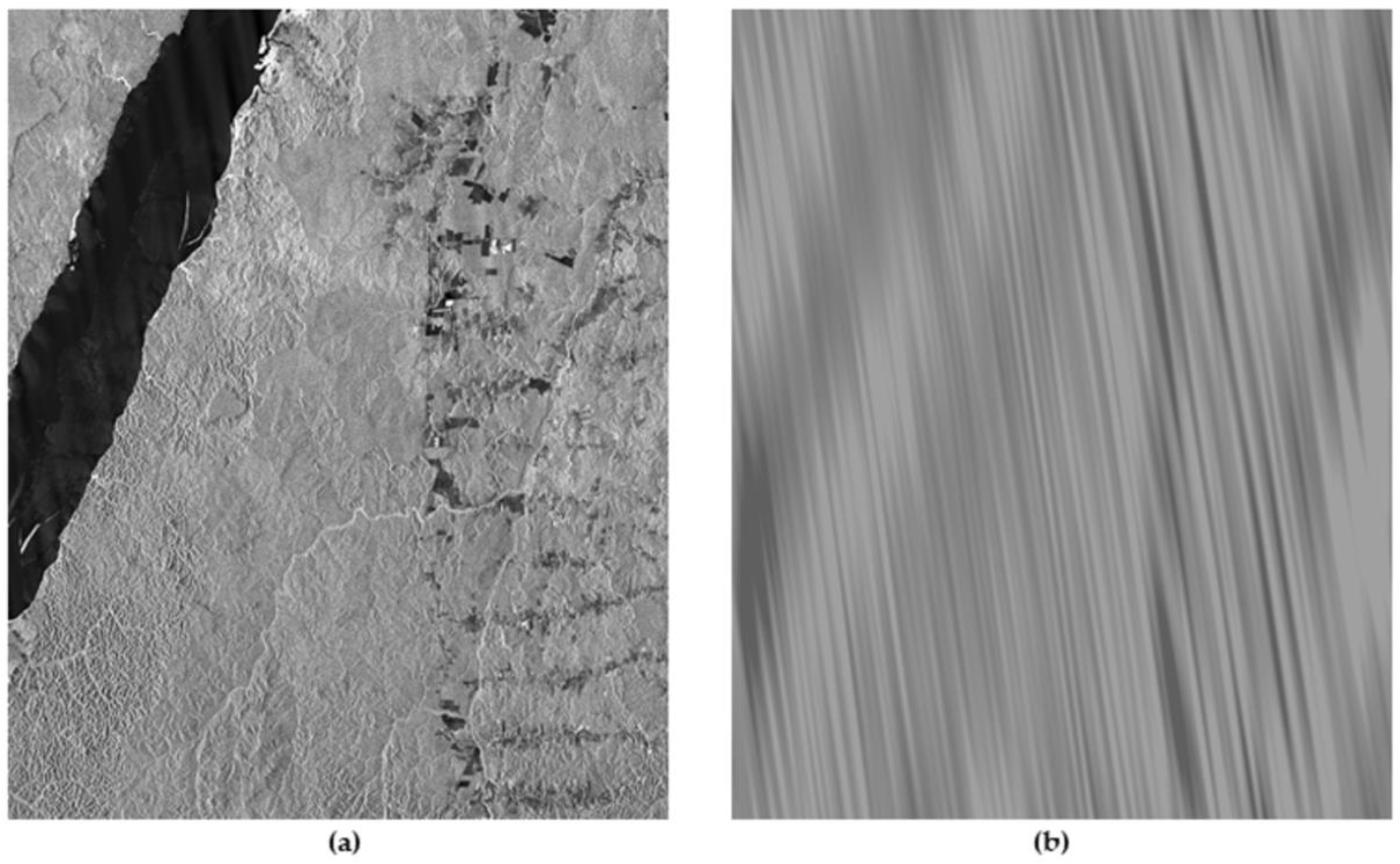
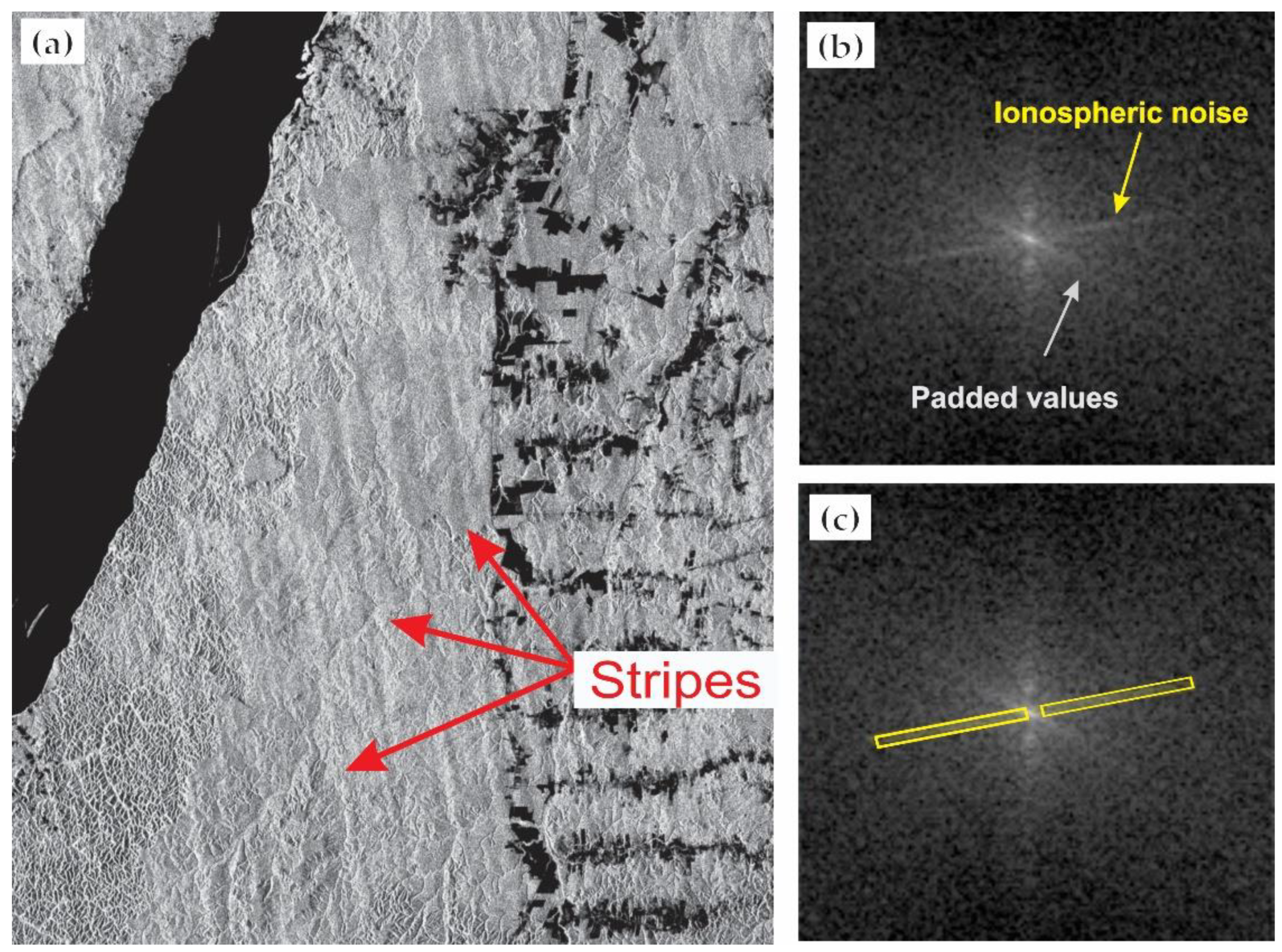

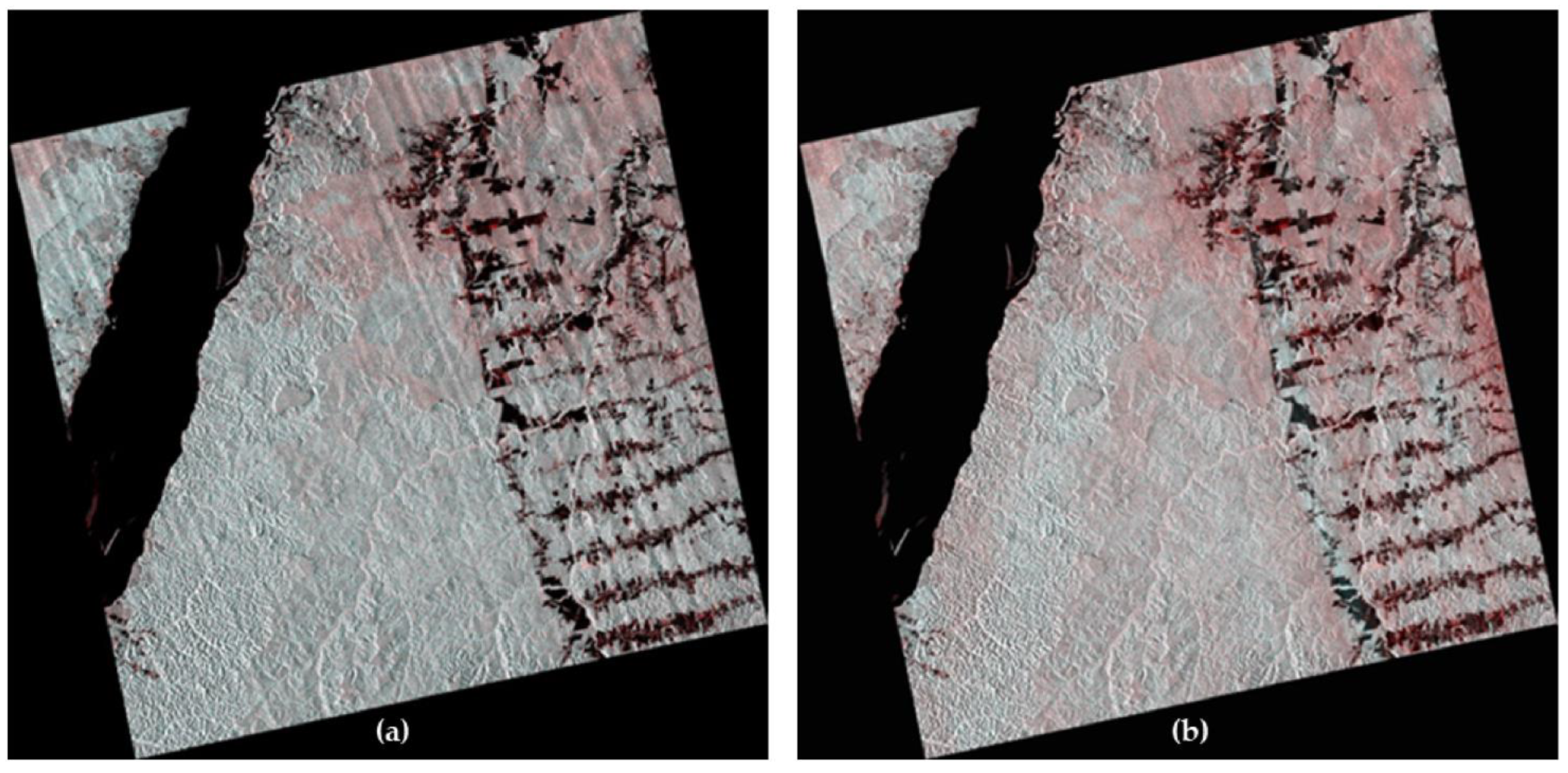
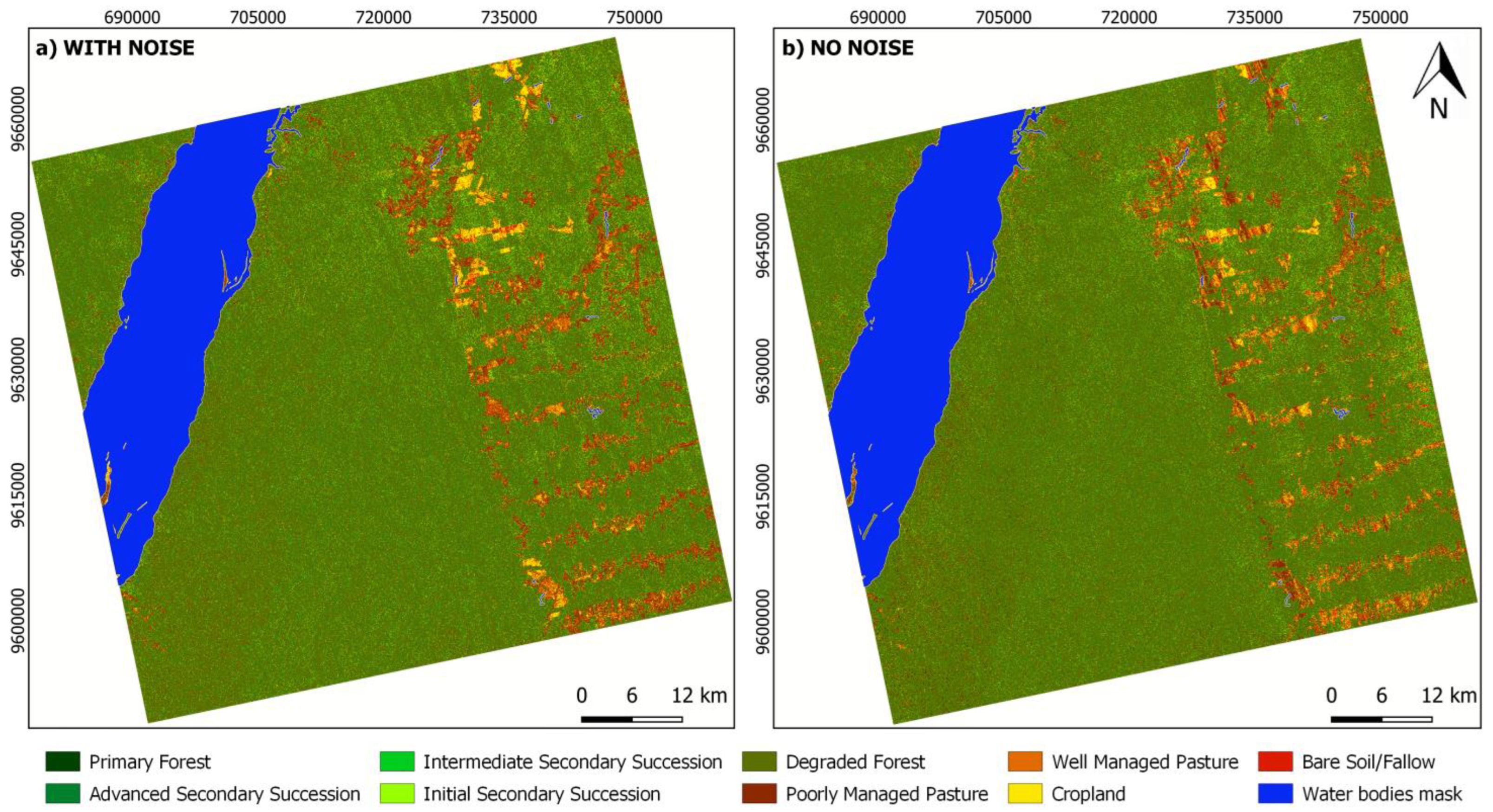
| Image | Orbit | Date | Polarization |
|---|---|---|---|
| ALOS2187487120-171112 | Ascending | 12 November 2017 | HH |
| HV |
| Class | Description | Class | Description |
|---|---|---|---|
| DF | Forests that suffered a slight loss of density due to indiscriminate logging and/or burning activities | CR | Agricultural crops throughout the phenological development phase |
| PF | Forests without anthropogenic change | BS | Temporary agricultural rest areas between growing seasons |
| SS3 | Natural regeneration over 15 years | WP | Well-managed pastures with few invasive species |
| SS2 | Natural regeneration from 5 to 15 years | PP | Pastures with the presence of species shrub weeds, babassu and/or inajá |
| SS1 | Natural regeneration under 5 years | -- | -- |
| Classes | PF | SS3 | SS2 | SS1 | PP | WP | CR | DF | BS |
|---|---|---|---|---|---|---|---|---|---|
| PF | 0 | 1 | 0 | 0 | 0 | 0 | 0 | 2 | 0 |
| SS3 | 1 | 2 | 2 | 0 | 0 | 0 | 0 | 5 | 0 |
| SS2 | 0 | 3 | 10 | 4 | 3 | 1 | 2 | 8 | 0 |
| SS1 | 3 | 0 | 3 | 11 | 12 | 2 | 6 | 10 | 0 |
| PP | 0 | 0 | 10 | 22 | 121 | 33 | 11 | 5 | 0 |
| WP | 0 | 0 | 0 | 2 | 17 | 54 | 2 | 0 | 3 |
| CR | 0 | 2 | 1 | 3 | 5 | 11 | 70 | 1 | 2 |
| DF | 12 | 14 | 11 | 10 | 7 | 0 | 5 | 98 | 0 |
| BS | 0 | 0 | 0 | 0 | 1 | 1 | 4 | 0 | 24 |
| Classes | PF | SS3 | SS2 | SS1 | PP | WP | CR | DF | BS |
|---|---|---|---|---|---|---|---|---|---|
| PF | 1 | 1 | 1 | 0 | 0 | 0 | 0 | 1 | 0 |
| SS3 | 1 | 6 | 1 | 0 | 0 | 0 | 0 | 5 | 0 |
| SS2 | 1 | 0 | 5 | 1 | 3 | 1 | 0 | 6 | 0 |
| SS1 | 5 | 4 | 3 | 18 | 5 | 1 | 5 | 6 | 0 |
| PP | 2 | 0 | 12 | 18 | 107 | 37 | 13 | 4 | 6 |
| WP | 0 | 0 | 1 | 1 | 31 | 48 | 9 | 0 | 3 |
| CR | 1 | 0 | 5 | 1 | 12 | 16 | 70 | 0 | 8 |
| DF | 9 | 11 | 12 | 9 | 4 | 0 | 0 | 94 | 0 |
| BS | 0 | 0 | 0 | 0 | 1 | 1 | 4 | 0 | 22 |
Publisher’s Note: MDPI stays neutral with regard to jurisdictional claims in published maps and institutional affiliations. |
© 2022 by the authors. Licensee MDPI, Basel, Switzerland. This article is an open access article distributed under the terms and conditions of the Creative Commons Attribution (CC BY) license (https://creativecommons.org/licenses/by/4.0/).
Share and Cite
Gama, F.F.; Wiederkehr, N.C.; da Conceição Bispo, P. Removal of Ionospheric Effects from Sigma Naught Images of the ALOS/PALSAR-2 Satellite. Remote Sens. 2022, 14, 962. https://doi.org/10.3390/rs14040962
Gama FF, Wiederkehr NC, da Conceição Bispo P. Removal of Ionospheric Effects from Sigma Naught Images of the ALOS/PALSAR-2 Satellite. Remote Sensing. 2022; 14(4):962. https://doi.org/10.3390/rs14040962
Chicago/Turabian StyleGama, Fábio Furlan, Natalia Cristina Wiederkehr, and Polyanna da Conceição Bispo. 2022. "Removal of Ionospheric Effects from Sigma Naught Images of the ALOS/PALSAR-2 Satellite" Remote Sensing 14, no. 4: 962. https://doi.org/10.3390/rs14040962
APA StyleGama, F. F., Wiederkehr, N. C., & da Conceição Bispo, P. (2022). Removal of Ionospheric Effects from Sigma Naught Images of the ALOS/PALSAR-2 Satellite. Remote Sensing, 14(4), 962. https://doi.org/10.3390/rs14040962






